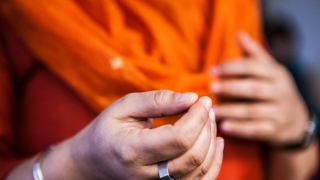
5 Vital Insights into Yoga Nidra
Are you truly practicing Yoga Nidra? Here’s what you need to know

![]() 2 minutes
•
4/2/23
2 minutes
•
4/2/23
Abstraction and concentration can be tricky—any second grader can tell you this. (They may not use those words, but they can tell you it’s much harder to multiply in your head than to use a tool/prop and exponentially harder when you have so many friends around!) In a world full of distraction and responsibilities, it’s not always easier as an adult to keep the wandering mind in line.
It is here that the yogic practitioner can turn to the subtle body, to chakras, to give us a tool that feels a little more tangible. Can’t you almost see the smoky purple color and the 16 petals of the Vishuddhi chakra in the throat region? We’ve heard before where the eye goes, the mind follows, but here we use the internal gaze as an anchor. The chakra gives us an internal focal point—antara dharana. While there is a much more to say about chakras, in the simplest form, we can think of these mysterious, lotus-like subtle structures as a tool we can use to connect to the self through meditation.
Awareness of the subtle, intangible, and all-pervading is what allows a practitioner to reach deeper states of consciousness. With each moment that we strengthen our practice with concentration on the chakras, we are that much closer to the state of Yoga.
LEARN MORE ABOUT CHAKRAS
Practice with me:
Listen to this podcast:
Bringing Clarity to Chakras Like Never Before on Let's Talk Yoga Podcast. Here
STAY IN TOUCH
Start your FREE subscription to Indu Arora's newsletter to get more on Yoga and Ayurveda here
Say hello on Instagram
Subscribe to my Youtube Channel.

Are you truly practicing Yoga Nidra? Here’s what you need to know

Mooladhara Chakra dharana: 10 minute meditation
Read more about chakras and Mooladhara Chakra here
LEARN MORE ABOUT CHAKRAS
Practice with me:
Listen to this podcast:
Bringing Clarity to Chakras Like Never Before on Let's Talk Yoga Podcast. Here

How much Ayurveda does a Yogi need to know? Conversely, how much Yoga does an Ayurveda person need to know? Consider this…from which eye do you prefer to see?